Atmospheric Response to Oceanic Cold Eddies West of Luzon in the Northern South China Sea
Abstract
1. Introduction
2. Data and Methods
2.1. Data
- (1)
- Delayed-time “allsat” product of altimetry sea level anomaly (SLA) and geostrophic velocity data on a 0.25° grid. The Ssalto/Duacs altimeter products were produced and distributed by the Copernicus Marine and Environment Monitoring Service (CMEMS) [41].
- (2)
- Optimally interpolated SST (OI_SST) product at 25-km resolution obtained from remote sensing systems [42].
- (3)
- Latent and sensible heat fluxes, ocean evaporation, and air temperature at 2 m height with 1° horizontal resolution, derived from the objectively analyzed air–sea fluxes (OA Flux) project of the Woods Hole Oceanographic Institution.
- (4)
- (5)
- Hourly rain rate dataset obtained from the Tropical Rainfall Measuring Mission (TRMM) 3b42 at a spatial resolution of 0.25° grid was used to describe the eddies’ impacts on the local precipitation [45].
- (6)
- Three-daily cloud liquid water average at 0.25° resolution from the TMI released by RSS (TMI v7.1) was also employed to verify the cloud response to the LCEs [46].
2.2. Methods
3. Atmospheric Responses to LCEs
3.1. Characteristics of the LCEs and Eddy-Related SST Anomalies
3.2. Eddy-Related Evaporation, Sea–Air Temperature Difference and Heat Fluxes Anomalies
3.3. Eddy-Related Surface Wind Speed Anomalies
3.4. Eddy-Related Divergence, Vorticity and Vertical Velocity Anomalies
3.5. Eddy-Related Cloud and Rain Rate Anomalies
3.6. Quantitative Analyses on the Eddy-Related Atmospheric Anomalies
4. Conclusions and Discussion
Supplementary Materials
Author Contributions
Funding
Conflicts of Interest
References
- Chelton, D.B.; Xie, S.P. Coupled ocean-atmosphere interaction at oceanic mesoscales. Oceanography 2010, 23, 52–69. [Google Scholar] [CrossRef]
- Bourras, D.; Reverdin, G.; Giordani, H.; Caniaux, G. Response of the atmospheric boundary layer to a mesoscale oceanic eddy in the Northeast Atlantic. J. Geophys. Res. 2004, 109, D18114. [Google Scholar] [CrossRef]
- Frenger, I.; Gruber, N.; Knutti, R.; Münnich, M. Imprint of Southern Ocean eddies on winds, clouds and rainfall. Nat. Geosci. 2013, 6, 608–612. [Google Scholar] [CrossRef]
- Putrasahan, D.A.; Miller, A.J.; Seo, H. Isolating mesoscale coupled ocean–atmosphere interactions in the Kuroshio Extension region. Dyn. Atmos. Oceans. 2013, 63, 60–78. [Google Scholar] [CrossRef]
- Byrne, D.; Papritz, L.; Frenger, I.; Münnich, M.; Gruber, N. Atmospheric response to mesoscale sea surface temperature anomalies: Assessment of mechanisms and coupling strength in a high-resolution coupled model over the South Atlantic. J. Atmos. Sci. 2015, 72, 1872–1890. [Google Scholar] [CrossRef]
- Nonaka, M.; Xie, S.P. Covariations of sea surface temperature and wind over the Kuroshio and its extension: Evidence for ocean-to-atmosphere feedback. J. Clim. 2003, 16, 1404–1413. [Google Scholar] [CrossRef]
- Chelton, D.B. Satellite measurements reveal persistent small-scale features in ocean winds. Science 2004, 303, 978–983. [Google Scholar] [CrossRef]
- O’Neill, L.W. Wind speed and stability effects on coupling between surface wind stress and SST observed from buoys and satellite. J. Climate. 2012, 2, 1544–1569. [Google Scholar] [CrossRef]
- Park, K.A.; Cornillon, P.; Codiga, D.L. Modification of surface winds near ocean fronts: Effects of Gulf Stream rings on scatterometer (QuikSCAT, NSCAT) wind observations. J. Geophys. Res. 2006, 111. [Google Scholar] [CrossRef]
- Spall, M.A. Midlatitude wind stress–sea surface temperature coupling in the vicinity of oceanic fronts. J. Clim. 2007, 20, 3785–3801. [Google Scholar] [CrossRef]
- Small, R.J.; deSzoeke, S.P.; Xie, S.P.; O’Neill, L.; Seo, H.; Song, Q.; Cornillon, P.; Spall, M.; Minobe, S. Air-sea interaction over ocean fronts and eddies. Dyn. Atmos. Oceans. 2008, 45, 274–319. [Google Scholar] [CrossRef]
- Chelton, D. Ocean-atmosphere coupling: Mesoscale eddy effects. Nat. Geosci. 2013, 6, 594–595. [Google Scholar] [CrossRef]
- Ma, J.; Xu, H.M.; Dong, C.M.; Lin, P.F.; Liu, Y. Atmospheric responses to oceanic eddies in the Kuroshio Extension region. J. Geophys. Res. 2015, 120, 6313–6330. [Google Scholar] [CrossRef]
- Chen, L.J.; Jia, Y.L.; Liu, Q.Y. Oceanic eddy-driven atmospheric secondary circulation in the winter Kuroshio Extension region. J. Oceanogr. 2017, 73, 295–307. [Google Scholar] [CrossRef]
- Wang, Y.H.; Liu, W.T. Observational evidence of frontal-scale atmospheric responses to Kuroshio extension variability. J. Clim. 2015, 28, 9459–9472. [Google Scholar] [CrossRef]
- Leyba, I.M.; Saraceno, M.; Solman, S.A. Air-sea heat fluxes associated to mesoscale eddies in the southwestern Atlantic Ocean and their dependence on different regional conditions. Clim. Dyn. 2016, 49, 2491–2501. [Google Scholar] [CrossRef]
- Ma, J.; Xu, H.M.; Dong, C.M. Seasonal variations in atmospheric responses to oceanic eddies in the Kuroshio Extension. Tellus A. Dyn. Meteorol. Oceanogr. 2016, 68. [Google Scholar] [CrossRef]
- Wang, G.H.; Su, J.L.; Chu, P.C. Mesoscale eddies in the South China Sea observed with altimeter data. Geophys. Res. Lett. 2003, 30, 2121. [Google Scholar] [CrossRef]
- Zhang, Z.; Tian, J.; Qiu, B.; Zhao, W.; Chang, P.; Wu, D.X.; Wan, X.Q. Observed 3D structure, generation, and dissipation of oceanic mesoscale eddies in the South China Sea. Sci. Rep. 2016, 6, 24349. [Google Scholar] [CrossRef] [PubMed]
- Zhuang, W.; Du, Y.; Wang, D.X.; Xie, Q.; Xie, S.P. Pathways of mesoscale variability in the South China Sea. Chin. J. Oceanol. Limnol. 2010, 28, 1055–1067. [Google Scholar] [CrossRef]
- Sun, S.W.; Fang, Y.; Liu, B.C.; Tana. Coupling between SST and wind speed over mesoscale eddies in the South China Sea. Ocean Dyn. 2016, 66, 1467–1474. [Google Scholar] [CrossRef]
- Yang, H.; Liu, Q. Forced Rossby wave in the northern South China Sea. Deep Sea Res. Part I 2003, 50, 917–926. [Google Scholar] [CrossRef]
- Wang, G.; Chen, D.; Su, J. Winter eddy genesis in the eastern South China Sea due to orographic wind jets. J. Phys. Oceanogr. 2008, 38, 726–732. [Google Scholar] [CrossRef]
- Metzger, E.J. Upper ocean sensitivity to wind forcing in the South China Sea. J. Oceanogr. 2003, 59, 783–798. [Google Scholar] [CrossRef]
- Sun, C.X.; Liu, Q.Y. Double eddy structure of the winter Luzon cold eddy based on satellite altimeter data. J. Trop. Oceanogr. 2011, 30, 9–15. [Google Scholar]
- Qu, T. Upper-layer circulation in the South China Sea. J. Phys. Oceanogr. 2000, 30, 1450–1460. [Google Scholar] [CrossRef]
- Chu, P.C.; Fan, C. Low salinity, cool-core cyclonic eddy detected northwest of Luzon during the South China Sea monsoon experiment (scsmex) in July 1998. J. Oceanogr. 2001, 57, 549–563. [Google Scholar] [CrossRef]
- Shaw, P.T.; Chao, S.Y.; Liu, K.K.; Pai, S.C.; Liu, C.T. Winter upwelling off Luzon in the northeastern South China Sea. J. Geophys. Res. 1996, 101, 16435–16448. [Google Scholar] [CrossRef]
- He, Y.; Cai, S.; Wang, D.; He, J. A model study of Luzon cold eddies in the northern South China Sea. Deep Sea Res. Part I. 2015, 97, 107–123. [Google Scholar] [CrossRef]
- Liu, H.; Li, W.; Chen, S.; Fang, R.; Li, Z. Atmospheric response to mesoscale ocean eddies over the South China Sea. Adv. Atmos. Sci. 2018, 35, 1189–1204. [Google Scholar] [CrossRef]
- Du, Y.Y.; Wu, D.; Liang, F.Y.; Yi, J.W.; Mo, Y.; He, Z.G.; Pei, T. Major migration corridors of mesoscale ocean eddies in the South China Sea from 1992 to 2012. J. Mar. Syst. 2016, 158, 173–181. [Google Scholar] [CrossRef]
- Chen, G.; Gan, J.; Xie, Q.; Chu, X.; Wang, D.; Hou, Y. Eddy heat and salt transports in the South China Sea and their seasonal modulations. J. Geophys. Res. 2012. [Google Scholar] [CrossRef]
- Abel, R.; Böning, C.W.; Greatbatch, R.J.; Hewitt, H.T.; Roberts, M.J. Feedback of mesoscale ocean currents on atmospheric winds in high-resolution coupled models and implications for the forcing of ocean-only models. Ocean Sci. Discuss. 2017, 1–22. [Google Scholar] [CrossRef]
- Gaube, P.; Chelton, D.B.; Samelson, R.M.; Schlax, M.G.; O’Neill, L.W. Satellite observations of mesoscale eddy-induced Ekman pumping. J. Phys. Oceanogr. 2015, 45, 104–132. [Google Scholar] [CrossRef]
- Chow, C.H.; Liu, Q.Y. Eddy effects on sea surface temperature and sea surface wind in the continental slope region of the northern South China Sea. Geophys. Res. Lett. 2012, 39, L02601. [Google Scholar] [CrossRef]
- Hayes, S.P.; McPhaden, M.J.; Wallace, J.M. The influence of sea-surface temperature on surface wind in the eastern equatorial Pacific: Weekly to monthly variability. J. Clim. 1989, 2, 1500–1506. [Google Scholar] [CrossRef]
- Wallace, J.M.; Mitchell, T.P.; Deser, C. The influence of sea-surface temperature on surface wind in the eastern equatorial Pacific: Seasonal and interannual variability. J. Clim. 1989, 2, 1492–1499. [Google Scholar] [CrossRef]
- Lindzen, R.S.; Nigam, S. On the role of sea surface temperature gradients in forcing low-level winds and convergence in the tropics. J. Atmos. Sci. 1987, 44, 2418–2436. [Google Scholar] [CrossRef]
- Mesoscale Eddies in Altimeter Observations of SSH. Available online: http://wombat.coas.oregonstate.edu/eddies/ (accessed on 4 October 2018).
- Williams, S.; Petersen, M.; Bremer, P.T.; Hecht, M.; Pascucci, V.; Ahrens, J.; Hlawitschka, M.; Hamann, B. Adaptive extraction and quantification of geophysical vortices. IEEE T. Vis. Comput. Gr. 2011, 17, 2088–2095. [Google Scholar] [CrossRef]
- Aviso global sea surface height products. Available online: https://www.aviso.altimetry.fr/en/data/products/sea-surface-height-products/global.html (accessed on 25 November 2018).
- The optimally interpolated SST (OI_SST) product. Available online: http://data.remss.com/SST/daily/ (accessed on 25 November 2018).
- Zhang, H.M.; Bates, J.J.; Reynolds, R.W. Assessment of composite global sampling: Sea surface wind speed. Geophys. Res. Lett. 2006, 33, L17714. [Google Scholar] [CrossRef]
- Blended Ocean Surface Vector Winds Distributed by the National Centers for Environmental Information of the NOAA. Available online: http://www.ncdc.noaa.gov/data-access/marineocean-data/blended-global/blended-sea-winds (accessed on 2 October 2018).
- Rain Rate Dataset Obtained from TRMM 3b42. Available online: https://doi.org/10.5067/TRMM/TMPA/3H/7 (accessed on 26 November 2018).
- Three-day Mean Cloud Liquid Water Dataset from the TMI Released by RSS (TMI v7.1). Available online: http://www.remss.com (accessed on 25 November 2018).
- Saha, S.; Moorthi, S.; Pan, H.L.; Wu, X.; Wang, J.; Nadiga, S.; Tripp, P.; Kistler, R.; Woollen, J.; Behringer, D.; et al. The NCEP climate forecast system reanalysis. Bull. Am. Meteorol. Soc. 2010, 91, 1015–1057. [Google Scholar] [CrossRef]
- Wen, C.; Xue, Y.; Kumar, A. Ocean-atmosphere characteristics of tropical instability waves simulated in the NCEP Climate Forecast System Reanalysis. J. Clim. 2012, 25, 6409–6425. [Google Scholar] [CrossRef]
- The CFSR Reanalysis Data. Available online: https://rda.ucar.edu/datasets/ds093.0/ (accessed on 24 August 2018).
- Cleveland, W.S. Robust locally weighted regression and smoothing scatterplots. J. Am. Stat. Assoc. 1979, 74, 829–836. [Google Scholar] [CrossRef]
- Hausmann, U.; Czaja, A. The observed signature of mesoscale eddies in sea surface temperature and the associated heat transport. Deep Sea Res. 2012, 70, 60–72. [Google Scholar] [CrossRef]
- Chen, G.; Hou, Y.; Chu, X.; Qi, P.; Hu, P. The variability of eddy kinetic energy in the South China Sea deduced from satellite altimeter data. Chin. J. Oceanol. Limnol. 2009, 27, 943–954. [Google Scholar] [CrossRef]
- Wang, C.; Wang, W.; Wang, D.; Wang, Q. Interannual variability of the South China Sea associated with El Nino. J. Geophys. Res. 2006, 111, C0323. [Google Scholar] [CrossRef]
- Song, Q.; Chelton, D.B.; Esbensen, S.K.; Thum, N.; O’Neill, L.W. Coupling between sea surface temperature and low-level winds in mesoscale numerical models. J. Clim. 2009, 22, 146–164. [Google Scholar] [CrossRef]
- O’Neill, L.W.; Chelton, D.B.; Esbensen, S.K. The effects of SST-induced surface wind speed and direction gradients on midlatitude surface vorticity and divergence. J. Clim. 2010, 23, 255–281. [Google Scholar] [CrossRef]
- Xu, Q.Q.; Xu, H.M.; Ma, J. Air-sea relationship associated with mesoscale oceanic eddies over the subtropical North Pacific in summer. Chin. J. Atmos. Sci. 2001, 42, 1191–1207. (In Chinese) [Google Scholar]
- O’Neill, L.W.; Chelton, D.B.; Esbensen, S.K. Observations of SST-induced perturbations of the wind stress field over the Southern Ocean on seasonal timescales. J. Clim. 2003, 16, 2340–2354. [Google Scholar] [CrossRef]
- Lambaerts, J.; Lapeyre, G.; Plougonven, R.; Klein, P. Atmospheric response to sea surface temperature mesoscale structures. J. Geophys. Res. 2013, 118, 9611–9621. [Google Scholar] [CrossRef]
- Renault, L.; Molemaker, M.J.; Mcwilliams, J.C.; Shchepetkin, A.; Florian, L.; Chelton, D.; Illig, S.; Hall, A. Modulation of wind-work by oceanic current interaction with the atmosphere. J. Phys. Oceanogr. 2016, 46, 1685–1704. [Google Scholar] [CrossRef]
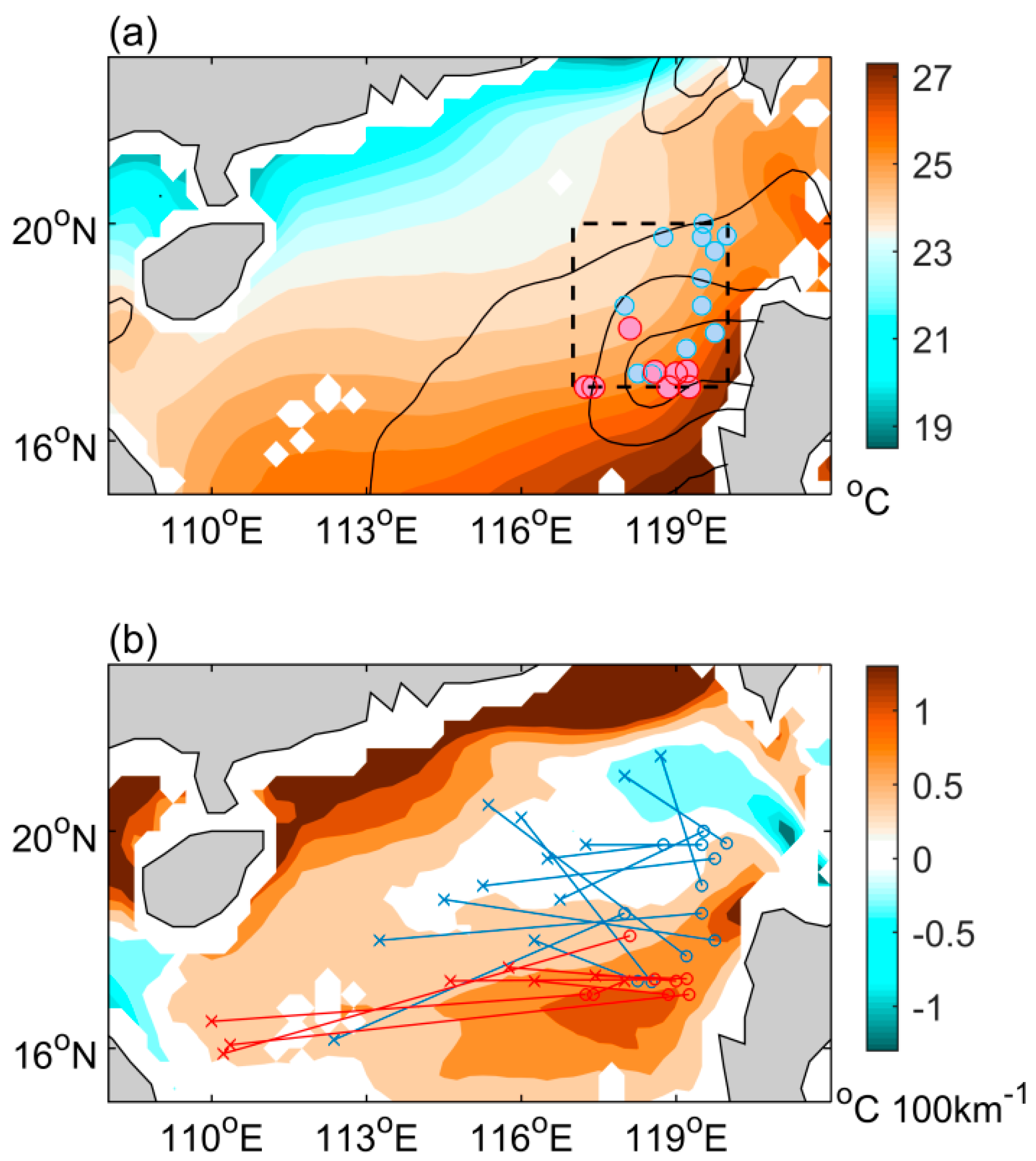
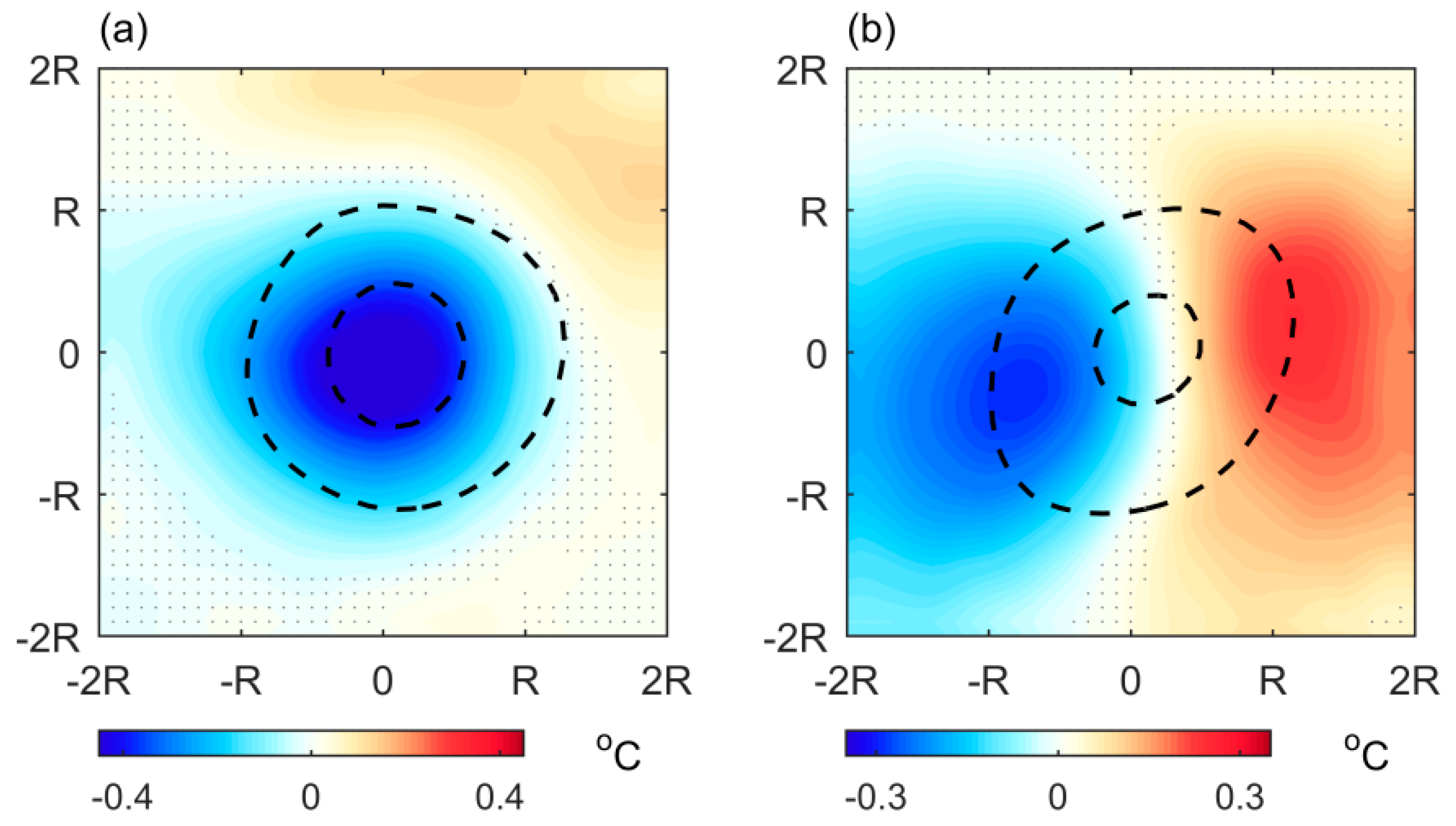
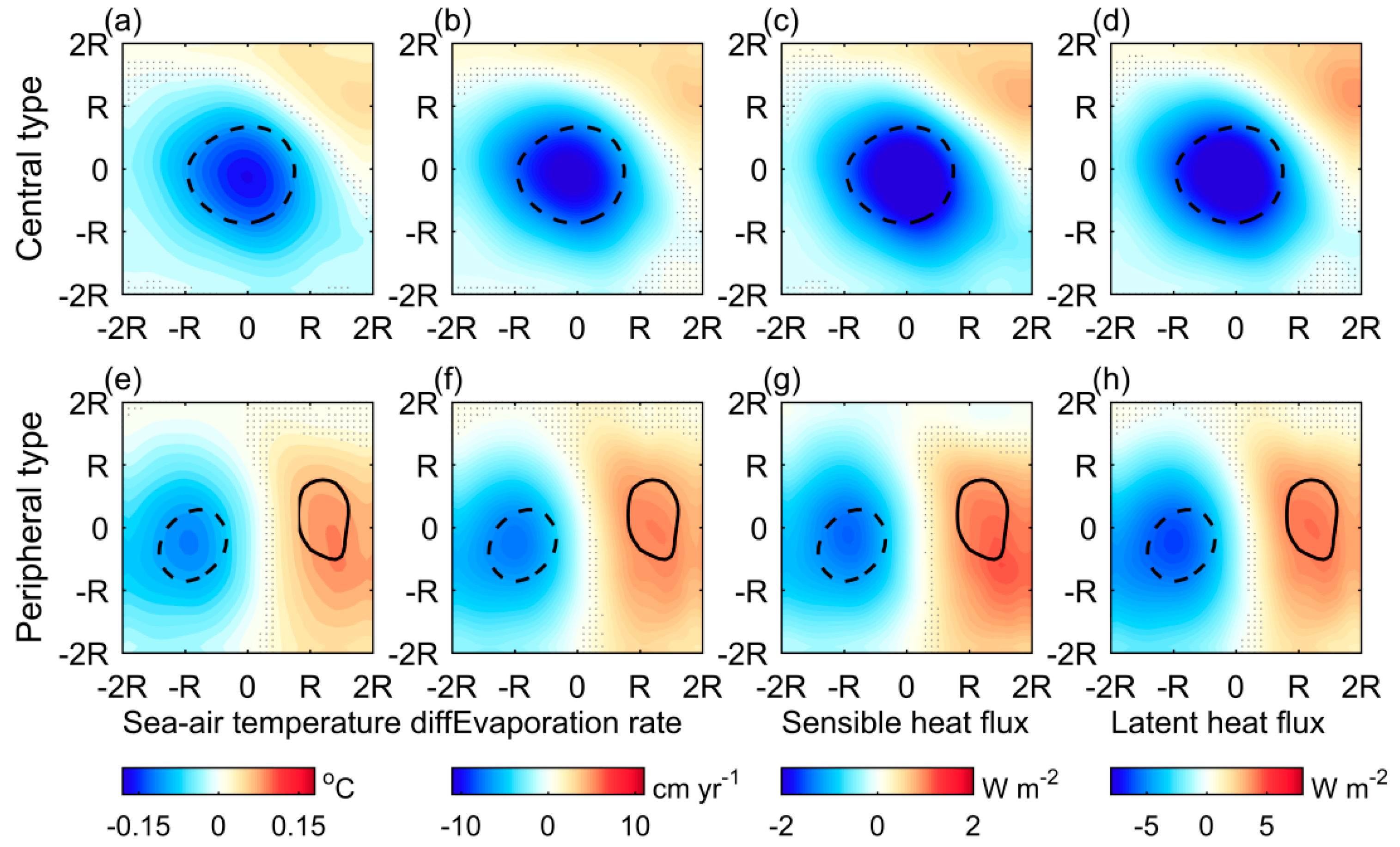
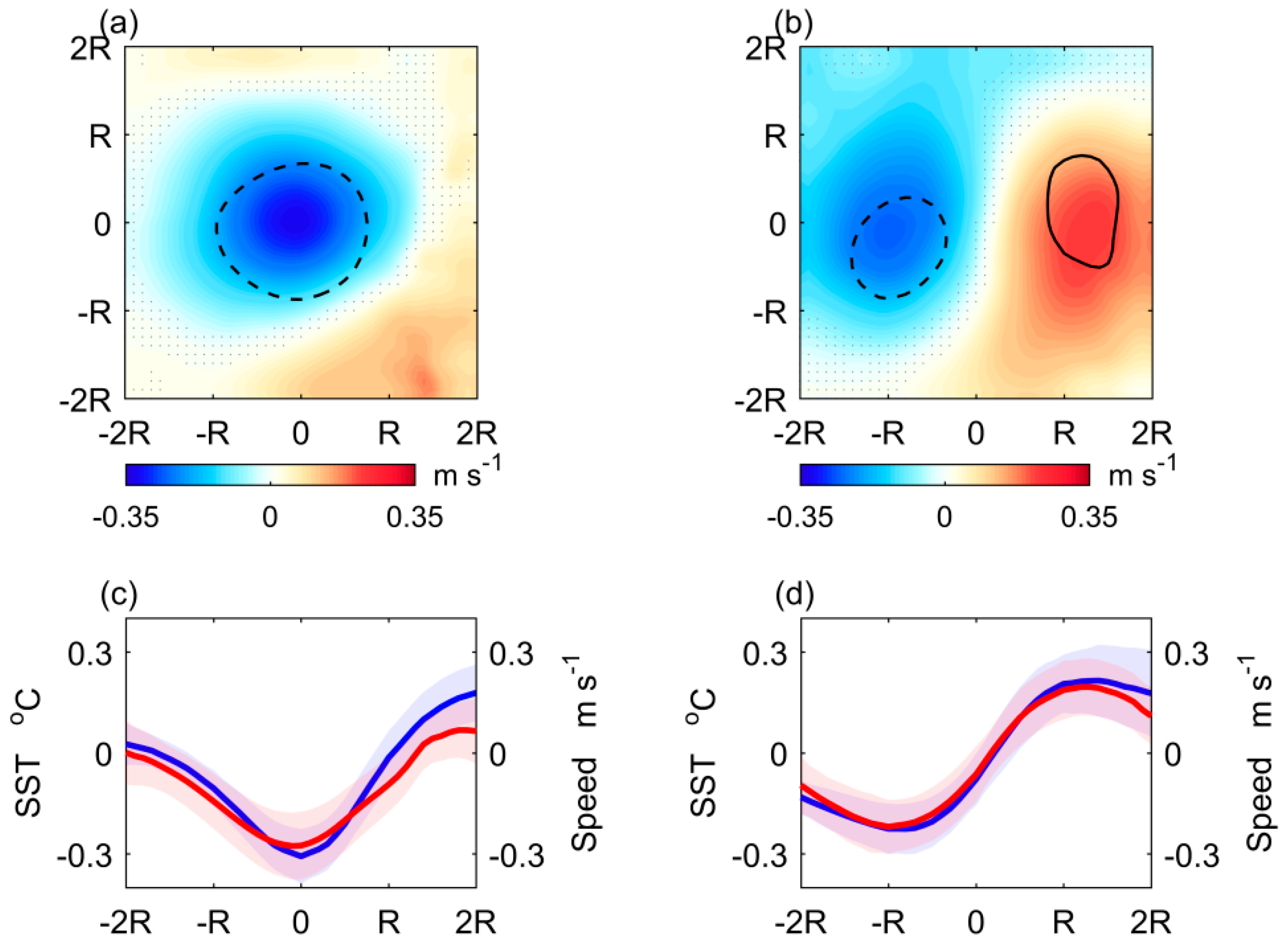
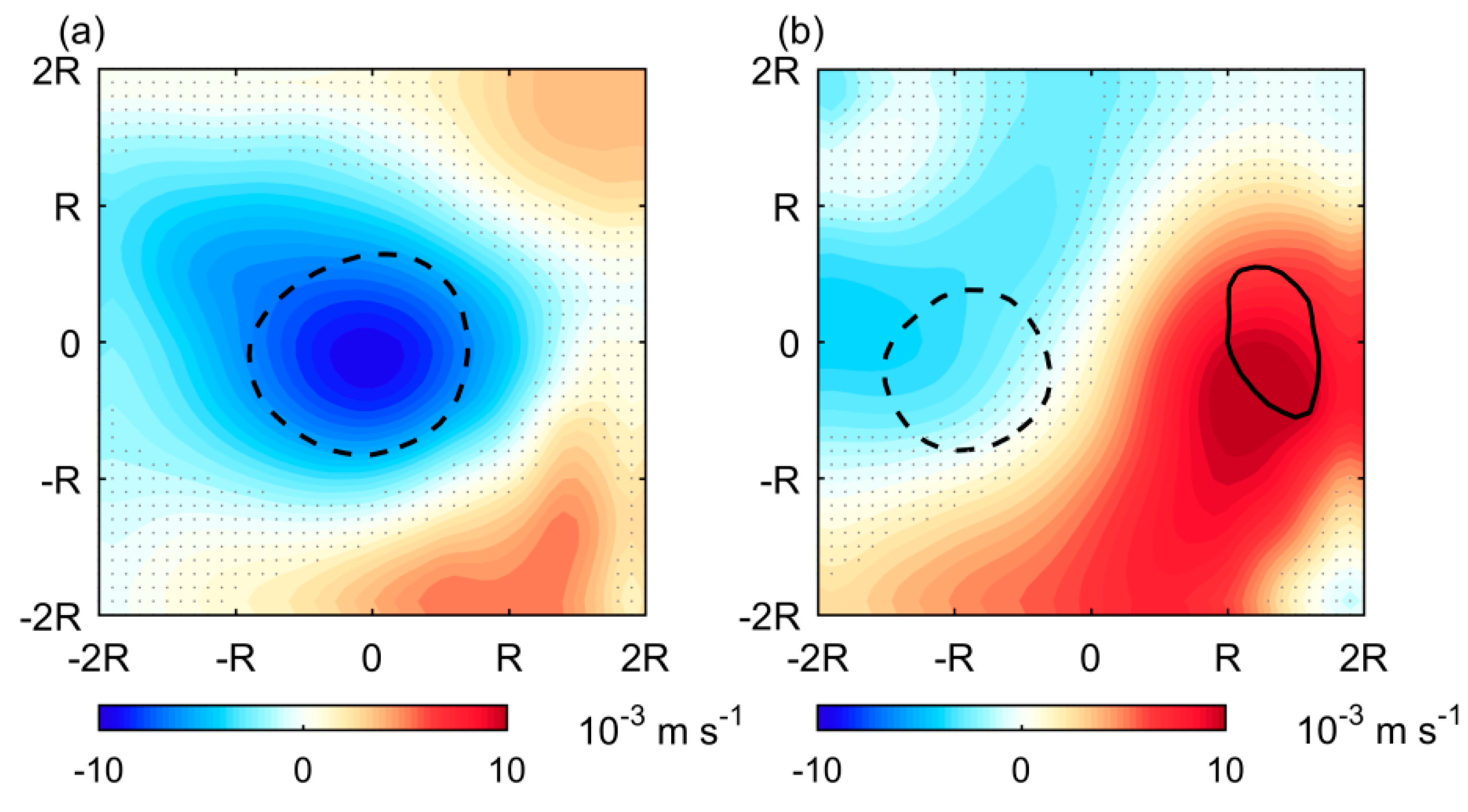
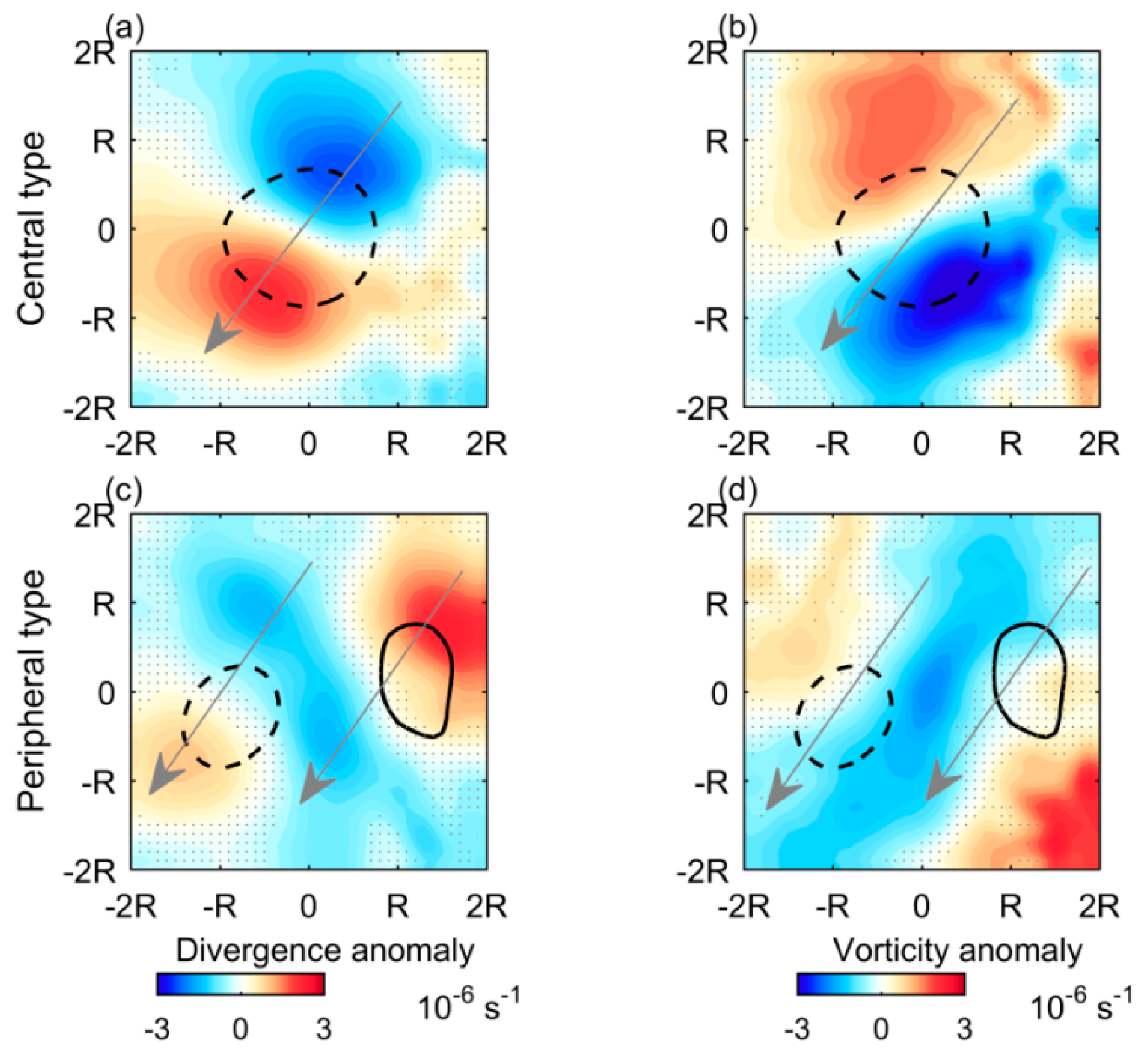
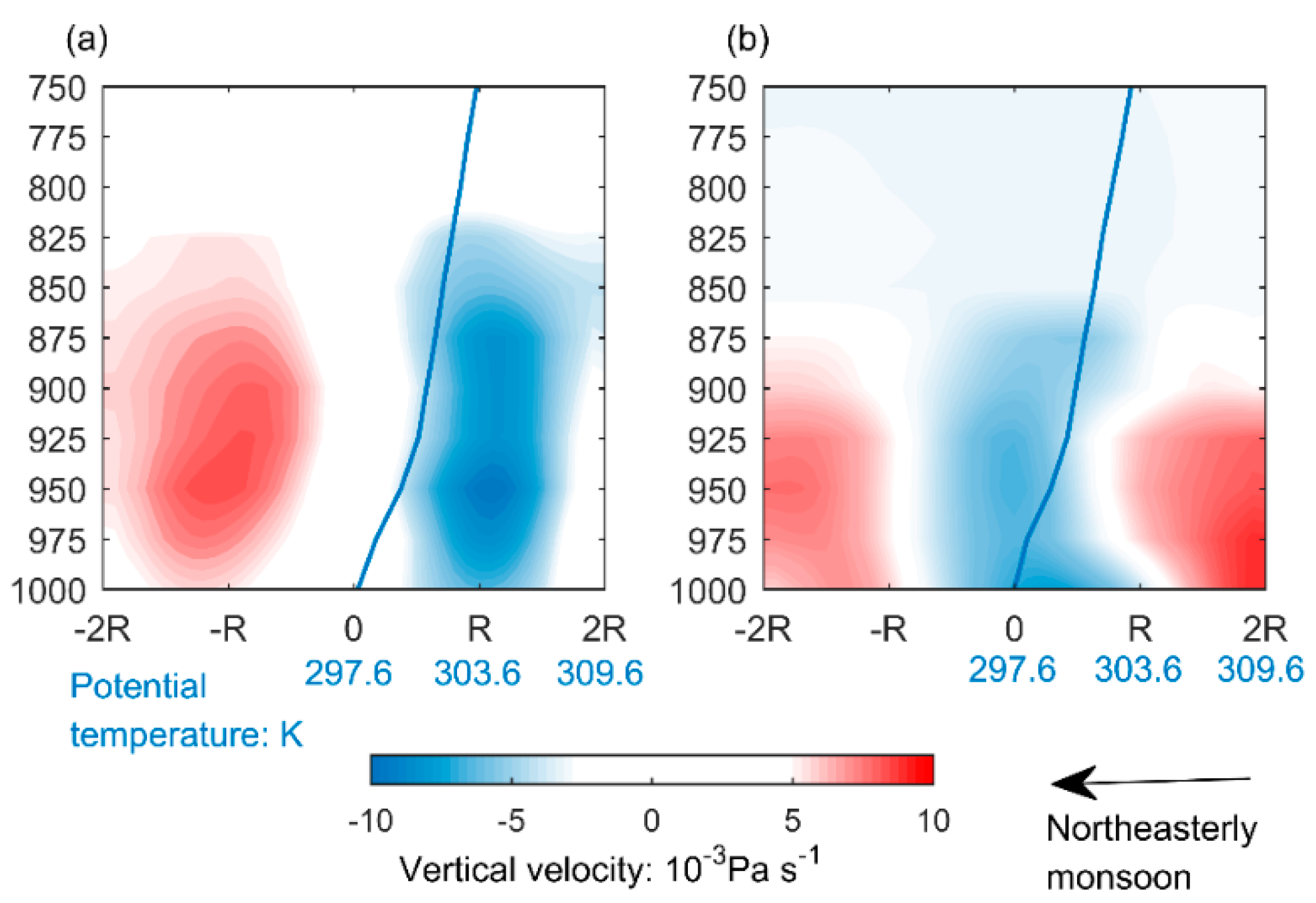
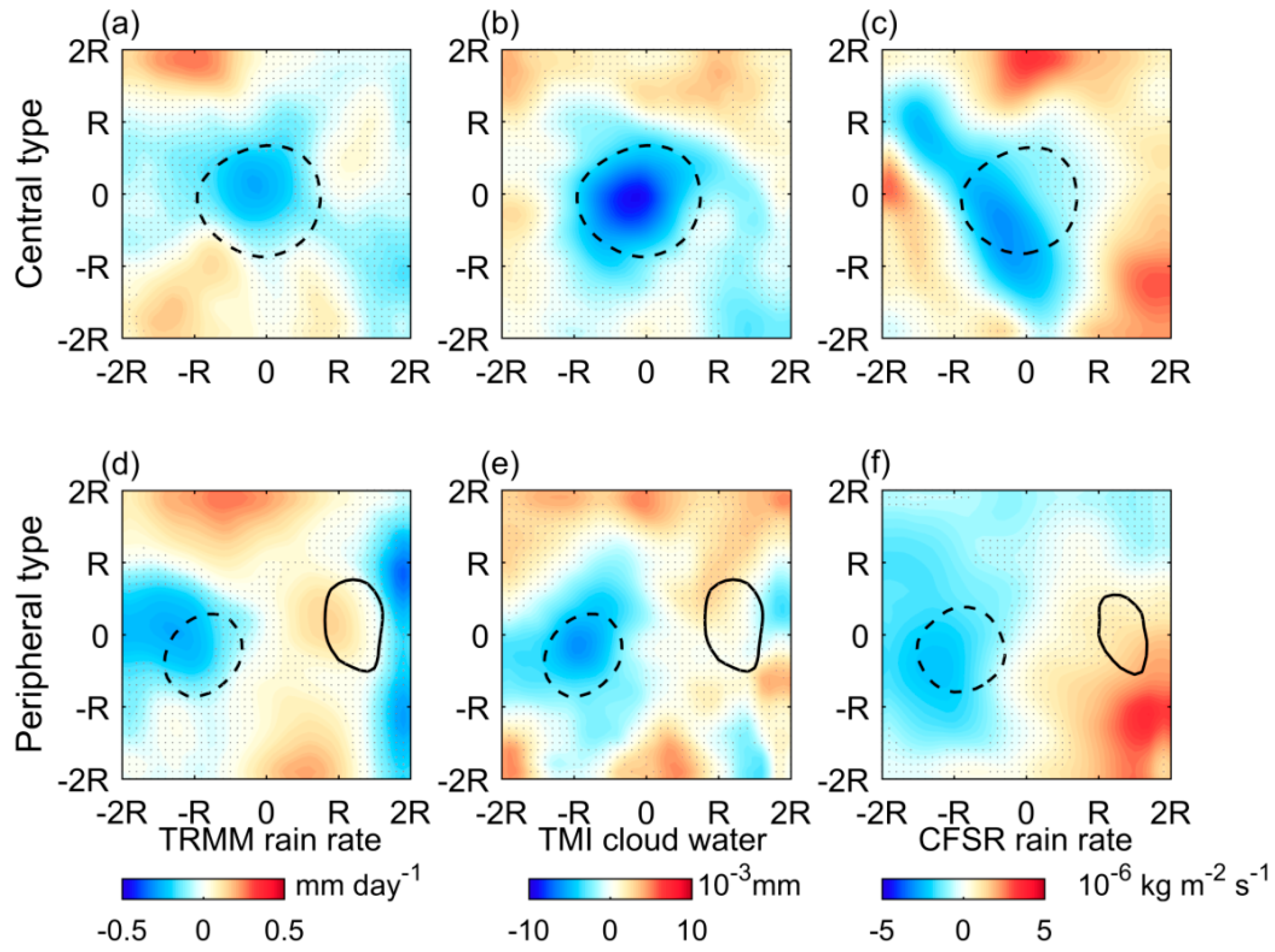
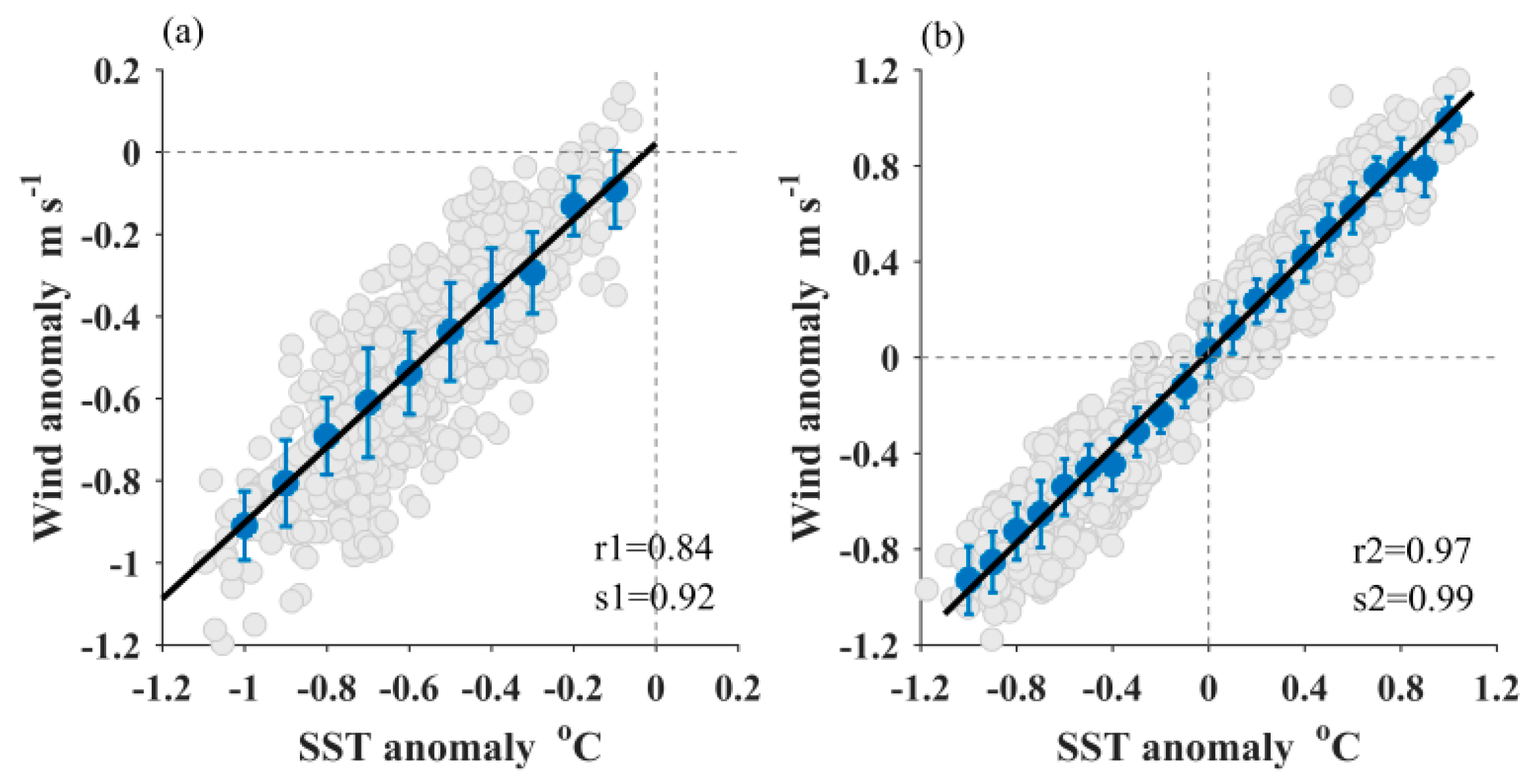
© 2019 by the authors. Licensee MDPI, Basel, Switzerland. This article is an open access article distributed under the terms and conditions of the Creative Commons Attribution (CC BY) license (http://creativecommons.org/licenses/by/4.0/).
Share and Cite
Liu, H.; Chen, S.; Li, W.; Fang, R.; Li, Z.; Wu, Y. Atmospheric Response to Oceanic Cold Eddies West of Luzon in the Northern South China Sea. Atmosphere 2019, 10, 255. https://doi.org/10.3390/atmos10050255
Liu H, Chen S, Li W, Fang R, Li Z, Wu Y. Atmospheric Response to Oceanic Cold Eddies West of Luzon in the Northern South China Sea. Atmosphere. 2019; 10(5):255. https://doi.org/10.3390/atmos10050255
Chicago/Turabian StyleLiu, Haoya, Shumin Chen, Weibiao Li, Rong Fang, Zhuo Li, and Yushi Wu. 2019. "Atmospheric Response to Oceanic Cold Eddies West of Luzon in the Northern South China Sea" Atmosphere 10, no. 5: 255. https://doi.org/10.3390/atmos10050255
APA StyleLiu, H., Chen, S., Li, W., Fang, R., Li, Z., & Wu, Y. (2019). Atmospheric Response to Oceanic Cold Eddies West of Luzon in the Northern South China Sea. Atmosphere, 10(5), 255. https://doi.org/10.3390/atmos10050255






